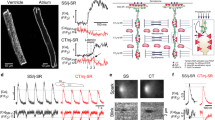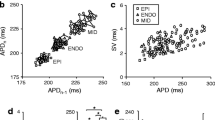Summary
Internal longitudinal resistance (ri), a determinant of cardiac conduction, is affected by changes in intracellular calcium and protons. However, the role and mechanism by which H+ and Ca2+ may modulate ri is uncertain. Cable analysis was performed in cardiac Purkinje fibers to measure ri during various interventions. In some experiments, intracellular pH (pHi) was recorded simultaneously to study the pHi-ri relation. Both intracellular Ca2+ and H+ independently modified ri. However, internal resistance of cardiac fibers was insensitive to pHi changes compared to other tissues. A latent period preceded the pHi-related changes in ri and the amount of change depended upon methodology. The results suggest that direct action of protons on ri may be subordinate to other regulatory processes. Ionic regulation of internal longitudinal resistance may occur by more than one mechanism: i) direct cationic binding to sites on junctional membrane proteins; and ii) H+- or Ca2+-dependent phosphorylation of junctional proteins.
Similar content being viewed by others
References
Arnsdorf, M.F., and Bigger, J.T. Jr, The effect of lidocaine on components of excitability in long mammalian cardic Purkinje fibers. J. Pharmac. exp. Ther.195 (1975) 206–215.
Arnsdorf, M.F., and Bigger, J.T. Jr, The effect of procaine amide on components of excitability in long mammalian cardiac Purkinje fibers. Circ. Res.38 (1976) 115–122.
Arnsdorf, M.F., and Friedlander, I., The electrophysiologic effects of tolamolol (UK-6558-01) on the passive membrane properties of mammalian cardiac Purkinje fibers. J. Pharmac. exp. Ther.199 (1976) 601–610.
Arnsdorf, M.F., and Sawicki, G.J., The effects of lysophosphatidylcholine, a toxic metabolite of ischemia, on the components of cardiac excitability in sheep Purkinje fibers. Circ. Res.49 (1981) 16–30.
Arnsdorf, M.F., Schmidt, G.A., and Sawicki, G.J., Effects of encainide on the determinants of cardiac excitability in sheep Purkinje fibers. J. Pharmac. exp. Ther.232 (1985) 40–48.
Baldwin, K.M., Cardiac gap junction configuration after an uncoupling treatment as a function of time. J. Cell Biol.82 (1979) 66–75.
Barr, L., Dewey, M.M., and Berger W., Propagation of action potentials and the structure of the nexus in cardiac muscle. J. gen. Physiol.48 (1965) 797–823.
Barry, W.H., and Smith, T.W., Mechanisms of transmembrane calcium movement in cultured chick embryo ventricular cells. J. Physiol.325 (1982) 243–260.
Bers, D.M., and Ellis, D., Intracellular calcium and sodium activity in sheep heart Purkinje fibres. Effect of changes of external sodium and intracellular pH. Pflügers Arch.393 (1982) 171–178.
Bredikis, Y.Y., Bukauskas, F.F., and Mutskus, K.S., Effect of hypoxia on cellular interaction in the myocardium. Bull. exp. Biol. Med.82 (1976) 1016–1019.
Byerly, L., and Moody, W.J., Intracellular calcium ions and calcium curents in perfused neurones of the snail,Lymnaea stagnalis. J. Physiol.352 (1984) 637–652.
Coraboeuf, E. and Weidmann, S., Temperature effects on the electrical activity of Purkinje fibres. Helv. physiol. pharm. Acta12 (1954) 32–41.
Dahl, G., and Isenberg, G., Decoupling of heart muscle cells: correlation with increased cytoplasmic calcium activity and with changes of nexus ultrastructure. J. Membr. Biol.53 (1980) 63–75.
Délèze, J., Calcium ions and the healing-over of heart fibres, in: Electrophysiology of the Heart, pp. 147–148. Eds B. Taccardi and G. Marchetti. Pergamon, Oxford 1965.
Délèze, J., The recovery of resting potential and input resistance in sheep heart injured by knife or laser. J. Physiol.208 (1970) 547–562.
Délèze, J., and Hervé, J.C., Effect of several uncouplers of cell-to-cell communication on gap junction morphology in mammalian heart. J. Membr. Biol.74 (1983) 203–215.
De Mello, W.C., and Dexter, D., Increased rate of sealing in beating heart muscle of the toad. Circ. Res. (1970) 481–489.
De Mello, W.C., Effect of intracellular injection of calcium and strontium on cell communication in heart. J. Physiol.250 (1975) 231–245.
De Mello, W.C., Influence of the sodium pump on intercellular communication in heart fibres: Effect of intracellular injection of sodium ion on electrical coupling. J. Physiol.263 (1976) 171–197.
De Mello, W.C., Effect of 2-4-dinitrophenol on intercellular communication in mammalian cardiac fibres. Pflügers Arch.380 (1979) 267–276.
De Mello, W.C., Effect of intracellular injection of La3+ and Mn2+ on electrical coupling of heart cells. Cell Biol. Int. Rep.3 (1979) 113–119.
De Mello, W.C., Influence of intracellular injection of H+ on the electrical coupling in cardiac Purkinje fibres. Cell Biol. int. Rep.4 (1980) 51–58.
De Mello, W.C., Effect of intracellular injection of cAMP on the electrical coupling of mammalian cardiac cells. Biochem. biophys. Res. Commun.119 (1984) 1001–1007.
Dominguez, G., and Fozzard, H.A., Influence of extracellular K+ concentration on cable properties and excitability of sheep cardiac Purkinje fibers. Circ. Res.26, (1970) 565–574.
Ewald, D.A., Williams, A., and Levitan, I.B., Modulation of single Ca2+-dependent K+-channel activity by protein phosphorylation. Nature, Lond.315 (1985) 503–506.
Fabiato, A., and Fabiato, F., Effects of pH on the myofilaments and the sarcoplasmic reticulum of skinned cells from cardiac and skeletal muscles. J. Physiol.276 (1978) 233–255.
Flagg-Newton, J.L., Dahl, G., and Loewenstein, W.R., Cell junction and cyclic AMP: I. Upregulation of junctional membrane permeability and junctional membrane particles by administration of cyclic nucleotide or phosphodiesterase inhibitor. J. Membr. Biol.63 (1981) 105–121.
Freygang, W.H., and Trautwein, W., The structural implications of the linear electrical properties of cardiac Purkinje strands. J. gen. Physiol.55 (1970) 524–547.
Haas, H.G., Meyer, R., Einwaechter, H.M., and Stockem, W., Intercellular coupling in frog heart muscle. Electrophysiological and morphological aspects. Pflügers Arch.399 (1983) 321–335.
Haiech, J., Klee, C.B., and Demaille, J.G., Effects of cations on affinity of calmodulin for calcium: Ordered binding of calcium ions allows the specific activation of calmodulin-stimulated enzymes. Biochemistry20 (1981) 3890–3897.
Hax, W.M.A., van Venrooij, G.E.P.M., and Vossenberg, J.B.J., Cell communication: A cyclic-AMP mediated phenomenon. J. Membr. Biol.19 (1974) 253–266.
Hertzberg, E.L., Spray, D.C., and Bennett, M.V.L., Reduction of gap junctional conductance by microinjection of antibodies against the 27-kDa liver gap junction polypeptide. Proc. natl Acad. Sci. USA82 (1985) 2412–2416.
Hofmann, H., Interaction between a normoxic and a hypoxic region of guinea pig and ferret papillary muscles. Circ. Res.56 (1985) 876–883.
Ikeda, K., and Hiraoka, M., Effects of hypoxia on passive electrical properties of canine ventricular muscle. Pflügers Arch.393 (1982) 45–50.
Inui, J., and Imamura, H., Effects of bufetolol and propranolol on active and passive membrane properties of dog papillary muscle. Jap. J. Pharmac.26 (1976) 639–647.
Jones, L.R., Sarcolemmal enzymes mediating β-adrenergic effects on the heart. Curr. Topics Membr. Trans.25 (1985) 11–41.
Kass, R.S., and Tsien, R.W., Multiple effects of calcium antagonists on plateau currents in cardiac Purkinje fibers. J. gen. Physiol.66 (1975) 169–192.
Kléber, A.G., Effects of sucrose solution on longitudinal tissue resistivity of trabecular muscle from mammalian heart. Pflügers Arch.345 (1973) 195–205.
Langer, G.A., and Frank, J.S., Lanthanum in heart cell culture. Effect on calcium exchange correlated with its localization. J. Cell Biol.54 (1972) 441–455.
Lee, K.S., and Tsien, R.W., Mechanism of calcium channel blockade by verapamil, D600, diltiazem and nitrendipine in single dialysed heart cells. Nature, Lond.302 (1983) 790–794.
Loewenstein, W.R., Nakas, M., and Socolar, S.J., Junctional membrane uncoupling. Permeability transformations at a cell membrane junction. J. gen. Physiol.50 (1967) 1865–1891.
Meech, R.W., Intracellular calcium injection causes increased potassium conductance inAplysia nerve cells. Comp. Biochem. Physiol.42A (1972) 493–499.
Nishiye, H., Mashima, H., and Ishida, A., Ca binding of isolated cardiac nexus membranes related to intercellular uncoupling. Jap. J. Physiol.30 (1980) 131–136.
Ochi, R., Electrical uncoupling by Sr action potentials in cardiac muscle. Experientia33 (1977) 1187–1188.
Page, E., Structural approaches to permeability of cardiac gap junctions, in: Normal and Abnormal Conduction in the Heart, pp. 29–41. Eds A. Paes de Carvalho, B.F. Hoffman and M. Lieberman. Futura, New York 1982.
Peracchia, C., and Peracchia, L.L., Gap junction dynamics: Reversible effects of divalent cations. J. Cell Biol.87 (1980) 708–718.
Peracchia, C., and Peracchia, L.L., Gap junction dynamics: Reversible effects of hydrogen ions. J. Cell Biol.87 (1980) 719–727.
Pressler, M.L., Cable properties and intracellular pH of sheep Purkinje fibers during CO2 alterations. Circulation72 (1985) III–36.
Pressler, M.L., Elharrar, V., and Bailey, J.C., Effects of extracellular calcium ions, verapamil, and lanthanum on active and passive properties of canine cardiac Purkinje fibers. Circ. Res.51 (1982) 637–651.
Reber, W.R., and Weingart, R., Influence of internal pH on the slow inward current and the contraction of Purkinje fibres from mammalian heart. Experientia35 (1979) 926.
Reber, W.R., and Weingart, R., Ungulate cardiac Purkinje fibres: The influence of intracellular pH on the electrical cell-to-cell coupling. J. Physiol.328 (1982) 87–104.
Reeves, J.P., and Sutko, J.L., Sodium-calcium ion exchange in cardiac membrane vesicles. Proc. natl. Acad. Sci. USA76 (1979) 590–594.
Revel, J.P., and Karnovsky, M.J., Hexagonal array of subunits in intercellular junctions of the mouse heart and liver. J. Cell Biol.33 (1967) C7-C12.
Rose, B., and Loewenstein, W.R., Permeability of cell junction depends on local cytoplasmic calcium activity. Nature, Lond.254 (1975) 250–252.
Rose, B., and Rick, R., Intracellular pH, intracellular free Ca, and junctional cell-cell coupling. J. Membr. Biol.44 (1978) 377–415.
Saez, J.C., Spray, D.C., Nairn, A.C., Hertzberg, E., Greengard, P., and Bennett, M.V.L., cAMP increases junctional conductance and stimulates phosphorylation of the 27-kDa principal gap junction polypeptide. Proc. natl Acad. Sci. USA83 (1986) 2473–2477.
Shibata, Y., and Page, E., Gap junctional structure in intact and cut sheep cardiac Purkinje fibers: A freeze-fracture study of Ca2+-induced resealing. J. Ultrastr. Res.75 (1981) 195–204.
Shoshan, V., MacLennan, D.H., and Wood, D.S., A proton gradient controls a calcium-release channel in sarcoplasmic reticulum. Proc. natl Acad. Sci. USA78 (1981) 4828–4832.
Spray, D.C., Harris, A.L., and Bennett, M.V.L., Gap junctional conductance is a simple and sensitive function of intracellular pH. Science211 (1981) 712–715.
Spray, D.C., Stern, J.H., Harris, A.L., and Bennett, M.V.L., Gap junctional conductance: Comparison of sensitivities to H and Ca ions. Proc. natl Acad. Sci. USA79 (1982) 441–445.
Spray, D.C., White, R.L., Campos de Carvalho, A., Harris, A.L., and Bennett, M.V.L., Gating of gap junction channels. Biophys. J.45 (1984) 219–230.
Tsien, R.W., and Weingart, R., Inotropic effect of cyclic AMP in calf ventricular muscle studied by a cut end method. J. Physiol.260 (1976) 117–141.
Turin, L., and Warner, A.E., Intracellular pH in earlyXenopus embryos: Its effect on current flow between blastomeres. J. Physiol.300 (1980) 489–504.
Vaughan-Jones, R.D., Lederer, W.J., and Eisner, D.A., Ca2+ ions can affect intracellular pH in mammalian cardiac muscle. Nature, Lond.301 (1983) 522–524.
Vercesi, A., Reynafarje, B., and Lehninger, A.L., Stoichiometry of H+ ejection and Ca2+ uptake coupled to electron transport in rat heart mitochondria. J. biol. Chem.253 (1978) 6379–6385.
Warner, A.E., Guthrie, S.C., and Gilula, N.B., Antibodies to gap-junctional protein selectively disrupt junctional communication in the early amphibian embryo. Nature, Lond.311 (1984) 127–131.
Weidmann, S., The electrical constants of Purkinje fibres. J. Physiol.118 (1952) 348–360.
Weidmann, S., The diffusion of radiopotassium across intercalated disks of mammalian cardiac muscle. J. Physiol.187 (1966) 323–342.
Weidmann, S., Electrical coupling between myocardial cells, in: Progress in Brain Research, vol. 31, pp. 275–281. Eds K. Akert and P.G. Waser. Elsevier, Amsterdam 1969.
Weingart, R., The actions of ouabain on intercellular coupling and conduction velocity in mammalian ventricular muscle. J. Physiol.264 (1977) 341–365.
Weingart, R., Hess, P., and Reber, W.R., Influence of intracellular pH on cell-to-cell coupling in sheep Purkinje fibers, in: Normal and Abnormal Conduction in the Heart, pp. 73–84. Eds A.P. de Carhalho, B.F. Hoffman and M. Lieberman. Futura, New York 1982.
Wojtczak, J., Contractures and increase in internal longitudinal resistance of cow ventricular muscle induced by hypoxia. Circ. Res.44 (1979) 88–95.
Wojtczak, J., Influence of cyclic nucleotides on the internal longitudinal resistance and contractures in the normal and hypoxic mammalian cardiac muscle. J. molec. cell. Cardiol.14 (1982) 259–265.
Author information
Authors and Affiliations
Rights and permissions
About this article
Cite this article
Pressler, M.L. Effects of pCai and pHi on cell-to-cell coupling. Experientia 43, 1084–1091 (1987). https://doi.org/10.1007/BF01956044
Published:
Issue Date:
DOI: https://doi.org/10.1007/BF01956044




